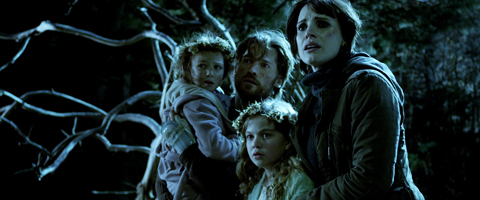Physical Address
304 North Cardinal St.
Dorchester Center, MA 02124
Physical Address
304 North Cardinal St.
Dorchester Center, MA 02124

Andy Muschietti’s directorial debut, “Mama,” has left a lasting impression on the horror genre since its release in 2013. The film, which originated from Muschietti’s own 2008 short film, delves deep into themes of motherhood, abandonment, and supernatural care. As we revisit this chilling tale, it’s crucial to understand the pivotal moments leading to its haunting conclusion and the implications it holds.
“Mama” introduces us to sisters Victoria and Lily, who are discovered in a dilapidated cabin after being lost in the woods for five years. Their uncle, Luke, and his girlfriend, Annabel, take them in, attempting to reintegrate the feral children into society. However, the girls have been under the care of a spectral entity they affectionately call “Mama.” This ghostly figure, born from tragedy, has become attached to the children and is not willing to let go easily.
Through the investigative efforts of Dr. Dreyfus and the visions experienced by Annabel, the backstory of “Mama” is pieced together. She was once Edith, a woman who faced immense sorrow after being separated from her child and subsequently dying in a tragic accident. Her spirit, unable to find peace, lingers in the mortal world, desperate to reclaim a maternal role with Victoria and Lily.
The climax of “Mama” is both dramatic and emotional. Annabel, having learned about Edith’s past, locates the remains of Edith’s infant and brings them to the cliff where the tragic death occurred. This act is meant to provide closure for Edith, allowing her spirit to rest. However, the situation escalates when Lily, still deeply connected to “Mama,” chooses to join the ghost in her eternal rest, leading to a poignant and visually striking conclusion where both disappear into a supernatural embrace, transforming into a cloud of moths.
This ending is significant as it symbolizes the release of Edith’s tormented soul and the tragic acceptance of Lily’s fate. Victoria, choosing to stay with Annabel, signifies her acceptance of her new life and the potential for healing. The moth landing on Victoria’s hand suggests that Lily’s spirit remains with her, offering a small comfort after such a profound loss.
The conclusion of “Mama” is rich with thematic depth, particularly in its exploration of motherhood. Annabel’s transformation from a reluctant caregiver to a protective maternal figure highlights her growth and the film’s nuanced portrayal of motherhood as a complex and powerful force. This transformation is underscored by Jessica Chastain’s portrayal of Annabel, whose initial reluctance gives way to fierce determination to protect her new family.
Moreover, the film presents a compelling discourse on the nature versus nurture debate. Victoria and Lily’s differing responses to their situation reflect their individual experiences and memories, shaping their decisions at the film’s climax. Lily’s choice to stay with “Mama” underscores her innate longing for the only mother she has known, highlighting the powerful bond formed by years of nurturing, despite the unnatural circumstances.
The cast and crew of “Mama” have shared insights that shed light on their interpretations of the film’s themes and ending. Director Andy Muschietti emphasized the importance of the film’s resolution in conveying the irreversible nature of Lily’s condition and her inevitable return to “Mama.” This perspective is supported by producer Guillermo del Toro, who advocated for preserving the film’s original ending to maintain its emotional and thematic integrity.
Visual effects supervisor Ed Taylor and Muschietti himself have discussed the film’s underlying message of hope and the profound definitions of parenthood, which resonate through Annabel’s heroic efforts and the tragic yet fitting conclusion of Lily’s story.
While “Mama” stands as a complete narrative, the success of the film sparked discussions of a potential sequel. Although plans for a follow-up have been tentative, the film’s enduring popularity and box office success suggest that the story’s universe has more to explore. However, any continuation would need to honor the original’s thematic depth and emotional impact.
In retrospect, “Mama” not only served as a launching pad for Muschietti’s career but also as a testament to his ability to craft deeply emotional narratives within the horror genre. The film’s exploration of maternal themes, combined with its supernatural elements, has left a lasting impact on audiences and continues to be a topic of discussion and analysis among horror enthusiasts.
1. What is the main theme of “Mama”?
The main theme of “Mama” revolves around motherhood and the complexities of maternal bonds, both natural and supernatural.
2. Why does Lily choose to stay with Mama at the end?
Lily’s decision is influenced by her deep, formative attachment to “Mama,” who has been her primary caregiver during her formative years in the wilderness.
3. What does the moth symbolize in the ending of “Mama”?
The moth symbolizes Lily’s spirit, suggesting that although she has passed on, her presence still lingers with Victoria.
4. Are there plans for a “Mama” sequel?
While there have been discussions about a sequel, no concrete plans have been announced, and the development of a follow-up remains uncertain.
5. How did “Mama” impact Andy Muschietti’s career?
“Mama” significantly boosted Muschietti’s profile, leading to further high-profile projects in both the horror genre and beyond, including adaptations of Stephen King’s “It” and a foray into the superhero genre with “The Flash.”
As “Mama” continues to be revisited and analyzed, its blend of horror and deep emotional storytelling ensures its place as a notable and impactful film within the genre.


